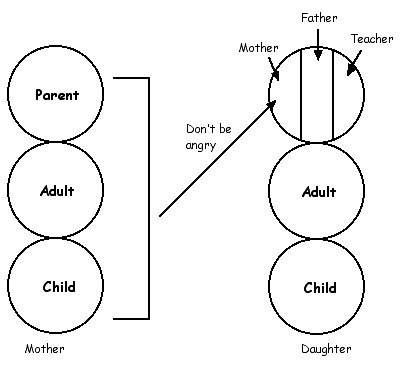Injunctions - early decisions by the child (Child ego state)
Parent communicates to the child in some form that it is not OK to feel and/or express anger. As the young child has no Adult or Parent ego state it accepts the message in its Little Professor ego state, (The Adult in the Child ego state (A1)). 1. The child hears the parental directive in its A1
2. The youngster also listens to its own feelings (provided by the C1) as a reaction to the directive .
3. The young child makes its early decision based on these two bits of information and stores that decision in the P1.

Modelling based Don’t be angry injunction (Parent ego state)
As the child grows it begins to store modelling in its Parent ego state in a very rudimentary form. These can never be fully expressed in a grown up way until the Parent ego state gains maturation in the teenage years. The young girl will model on mother and if mother has a strong aversion to expressing or feeling anger the daughter will model that and incorporate it into her own Parent ego state.

The more the Child ego state decisions are consistent with the Parent ego state modelling the stronger the influence in the personality. At times they will be consistent and at other times they can be direct opposites. Consider this example. Johnny gets angry and hits his sister on the head with a piece of wood. On seeing this mother approaches Johnny angrily. With a raised angry voice she smacks Johnny on the back side and tells him not to hit his sister.
Johnny thinks in his A1 ego state. I was angry, that made mother very frightening to me and I got hit so I decide, “Don’t feel angry”. (Child ego state)
At the same time Johnny models on mother’s anger and her expression of that anger by hitting. (Parent ego state)
Thus the Child decisions about anger and the Parent modelling about anger are contradictory.

Problems with feeling and expressing anger
Starting with the most serious psychopathology moving to the least.
1. Don’t be sane. This person does not even acknowledge that a event has occurred that one could feel about. One may have been put down or say ridiculed and the individual does not even recognise that the event has occurred. The Adult ego state is so dysfunctional the facts of the situation are not recognised or comprehended.
2. Don’t feel. This person recognises that an event has occurred but does not feel anything in response to it. Person gets their wallet stolen but has no feelings about it.
3. Don’t feel X, feel Y. Person acknowledges the event, has a feeling in response to the event but it is not the appropriate feeling. Instead of feeling angry at being unjustly criticised the person feels scared or embarrassed. Women will often feel scared instead of angry and men will often feel anger instead of scared.
4. Don’t express your feelings. This person acknowledges an event has occurred, feels the appropriate feeling about it, but does not express the feeling.
5. Feel X, but express Y. This person acknowledges an event has occurred, feels the appropriate feeling about it, expresses the feeling but it is the inappropriate feeling. The woman who feels angry and then cries, the man who feels sad but shows anger
(Ref: Treatment of character)
Graffiti
Ooooh, what a great post. Good for you for really understanding all of these points. You might (or might not) be surprised at how many therapists claim to understand these ideas, yet I'm sure they could never articulate them as you have done. And so they cannot practice them. It is not rare for a therapist to find out a client's feelings about something and then try to 'trick' the client into falsely substituting a more 'socially acceptable' feeling (or one that would make the therapist feel better and less in danger from his or her own stifling inner parent). Good job here, Tony.
ReplyDeleteThanks for your comments Anon.
ReplyDeleteAs you note "No go" zones are interesting things for therapists
Cheers
Tony